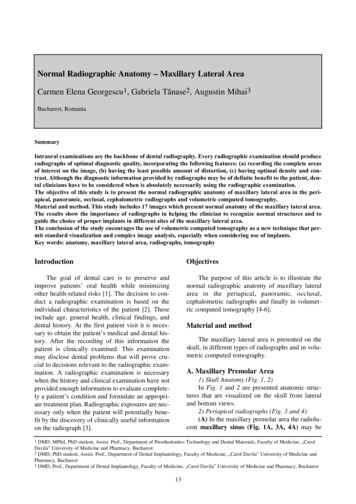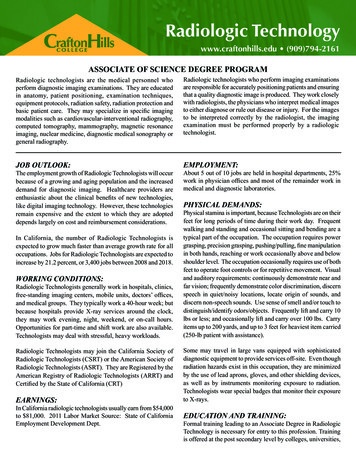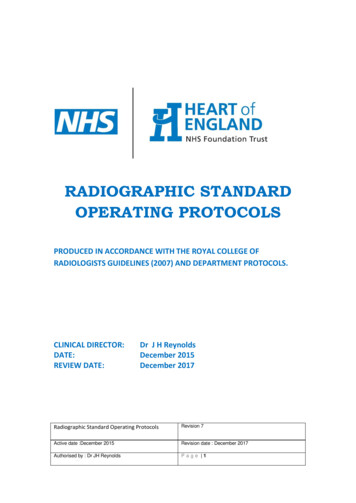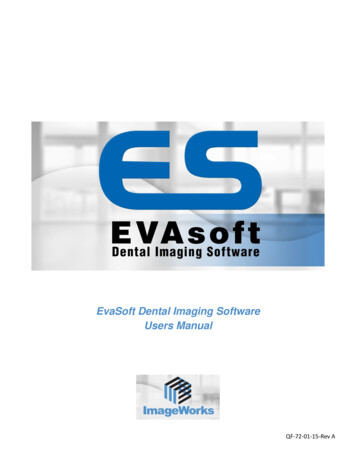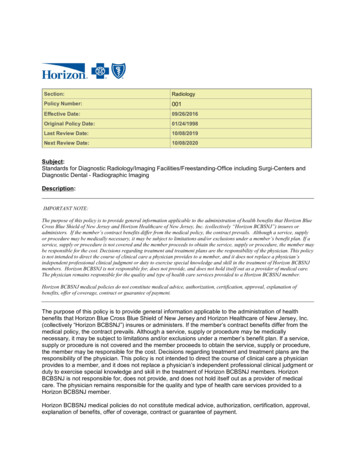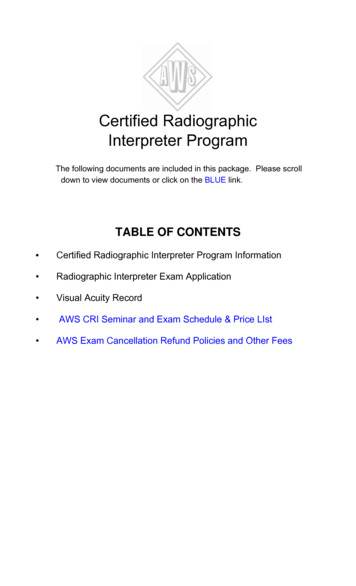
Transcription
RADIOGRAPHICPATHOLOGYFORTECHNOLOGISTSSixth EditionNINA KOWALCZYK, PHD, RT(R)(QM)(CT), FASRTAssistant ProfessorRadiologic Sciences and TherapyThe School of Health and Rehabilitation SciencesThe Ohio State UniversityColumbus, Ohio
3251 Riverport LaneMaryland Heights, MO 63043RADIOGRAPHIC PATHOLOGY FOR TECHNOLOGISTSCopyright 2014 by Mosby, an imprint of Elsevier Inc.Copyright 2009, 2004, 1998, 1994, 1988 by Mosby, Inc.978-0323-08902-9All rights reserved. No part of this publication may be reproduced or transmitted in any form or byany means, electronic or mechanical, including photocopying, recording, or any information storageand retrieval system, without permission in writing from the publisher. Permissions may be soughtdirectly from Elsevier’s Rights Department: phone: ( 1) 215 239 3804 (US) or ( 44) 1865 843830(UK); fax: ( 44) 1865 853333; e-mail: healthpermissions@elsevier.com. You may also complete yourrequest on-line via the Elsevier website at ge and best practice in this field are constantly changing. As new research and experiencebroaden our knowledge, changes in practice, treatment and drug therapy may become necessaryor appropriate. Readers are advised to check the most current information provided (i) onprocedures featured or (ii) by the manufacturer of each product to be administered, to verify therecommended dose or formula, the method and duration of administration, and contraindications.It is the responsibility of the practitioner, relying on their own experience and knowledge of thepatient, to make diagnoses, to determine dosages and the best treatment for each individualpatient, and to take all appropriate safety precautions. To the fullest extent of the law, neither thePublisher nor the Authors assume any liability for any injury and/or damage to persons orproperty arising out of or related to any use of the material contained in this book.The PublisherLibrary of Congress Control Number 2007932477Kowalczyk, Nina, author.Radiographic pathology for technologists / Nina Kowalczyk. – Sixth edition.p. ; cm.Includes bibliographical references and index.ISBN 978-0-323-08902-9 (pbk. : alk. paper)I. Title.[DNLM: 1. Radiography–methods. 2. Pathology–methods. WN 200]RC78616.07–dc23Executive Content Strategist: Sonya SeigafuseContent Development Specialist: Amy WhittierPublishing Services Manager: Catherine JacksonProduction Editor: Sara AlsupDesign Direction: Paula CatalanoPrinted in ChinaLast digit it the print number: 98 7 65 43 2 12013021567
CONTRIBUTORSKevin D. Evans, PhD, RT(R)(M)(BD), RDMS,RVS, FSDMSAssociate Professor/DirectorRadiologic Sciences and TherapyThe School of Health and RehabilitationSciencesThe Ohio State UniversityColumbus, OhioTricia Leggett, DHEd, RT(R)(QM)Assistant Professor and Radiologic TechnologyClinical CoordinatorAssessment CoordinatorZane State CollegeZanesville, OhioJonathan Mazal, MS, RT(R)(MR), RRAMRI TechnologistNational Institutes of HealthBethesda, Maryland*Contributing in his personal capacityBeth McCarthy, BS, RT(R)(CV)Research CoordinatorCardiovascular MedicineThe Ross Heart Hospital at The Ohio StateUniversity Wexner Medical CenterColumbus, Ohioiii
REVIEWERSDeanna Butcher, MA, RT(R)Program DirectorSt. Cloud Hospital School of DiagnosticImagingSt. Cloud, MinnesotaJeannean Rollins, MRC, BSRT(R)(CV)Associate Professor, Medical Imaging andRadiation Sciences DepartmentArkansas State UniversityJonesboro, ArkansasRobert J. Comello, MS, RT(R)(CDT)Radiologic Science ProgramMidwestern State UniversityWichita Falls, TexasMelissa Hale Smith, BSRT(R)(MR)(CT),CNMTInstructor, Magnetic Resonance ImagingProgramForsyth Technical Community CollegeWinston-Salem, North CarolinaGail Faig, BS, RT(R)(CV)(CT)Clinical CoordinatorShore Medical CenterSomers Point, New JerseyKelli Haynes, MSRS, RT(R)Program DirectorNorthwestern State UniversityShreveport, LouisianaDeborah R. Leighty, MEd, RT(R)(BD)Clinical Coordinator, Radiography ProgramHillsborough Community CollegeTampa, FloridaMarcia Moore, BS, RT(R)(CT)InstructorSt. Luke’s CollegeSioux City, IowaivStaci Smith, RT(R), MHAProgram DirectorHoly Cross Hospital School of RadiologicTechnologySilver Spring, MarylandTimothy Whittaker, MS, RT(R)(CT)(QM)Associate Professor of RadiologyHazard Community and Technical CollegeHazard, Kentucky
PREFACEvPREFACEThe sixth edition of Radiographic Pathology forTechnologists has been thoroughly updated andrevised to offer students and medical imagingprofessionals information on the pathologicappearance of common diseases in a variety ofdiagnostic imaging modalities. It also presentsbasic information on the pathologic process,signs and symptoms, diagnosis, and prognosis ofthe various diseases.The sixth edition includes the latest information concerning recent advances in geneticmapping, biomarkers, and up-to-date imagingmodalities used in daily practice. The authorshave attempted to present this material in a succinct, but reasonably complete, fashion to meetthe needs of professionals in various imagingspecialties. With each new edition, the authorshave also expanded the scope of the materialcovered in the text to provide the reader with abroader base of knowledge.NEW TO THIS EDITION The chapter order and arrangement havebeen changed to accommodate the generalrevision of existing material.Over 50 new illustrations have been added tocomplement new, updated, or expandedmaterial.Human genetic technology information hasbeen expanded, and altered cell biology hasbeen added to Chapter 1.Genetic marker and information regardingbiomarkers have been added throughout thetext.The most recent American College of Radiology Appropriateness Criteria has been incorporated throughout the text.Several new terms have been added to theglossary, and other definitions have beenexpanded or updated.LEARNING ENHANCEMENTS Each chapter begins with an outline, followedby key terms and learning objectives.Chapter content is followed by a summarytable, general discussion questions, and multiple-choice review questions, all of whichcan be used by the reader to assess acquiredknowledge or by the instructor to stimulatediscussion.Bold print has been used to focus the reader’sattention on the key terms in each chapter,which are defined in the glossary at the endof the book along with other relevant terms.USING THE BOOKThe presentation of the sixth edition presumesthat the reader has some background in humananatomy and physiology, imaging procedures,and medical and imaging terminology. The readermay build on this knowledge by assimilatinginformation presented in this text.To facilitate a working knowledge of the principles of radiologic pathology, study materialspresented in the sixth edition remain sophisticated enough to be true to the complexity of thesubject, yet simple and concise enough to permitcomprehension by all readers. For student radiographers, sonographers, radiation therapists, andnuclear medicine technologists, this text is bestused in conjunction with formal instruction froma qualified instructor. The practicing imagingprofessional may use this book as a self-teachinginstrument to broaden and reinforce existingknowledge of the subject matter and also as ameans to acquaint himself or herself with changing concepts and new material. The book canserve as a resource for continuing educationbecause it provides an extensive range ofinformation.v
viPREFACEANCILLARIESEvolve ResourcesEvolve is an interactive learning environmentdesigned to work in coordination with Radiographic Pathology for Technologists. Includedon the Evolve website are a test bank in ExamView containing approximately 400 questions,an electronic images collection consisting ofimages from the textbook, and a PowerPointpresentation. Instructors may use Evolve toprovide an Internet-based course componentthat reinforces and expands the concepts presented in class. Evolve may be used to publishthe class syllabus, outlines, and lecture notes;set up “virtual office hours” and e-mail communication; share important dates and information through the online class calendar;and encourage student participation throughchat rooms and discussion boards. Evolvealso allows instructors to post examinationsand manage their grade books online. Formore information, visit http://evolve.elsevier.com/Kowalczyk/pathology/ or contact an Elsevier sales representative.ACKNOWLEDGMENTSOver twenty years ago, two young and fairlynaïve radiography educators collaborated toundertake the task of developing a pathologytextbook for radiography students. At that time,only one small textbook was commercially available and little did we know that the text-bookwe conceived and created would result in fivesubsequent editions spanning almost 25 years!As I began to revise this sixth edition, I wasamazed at the changes that have occurred overthe past 20 years relative to understanding pathologic processes. Great strides have been made ingenetic mapping and the identification of biomarkers that allow the advent of personalizedmedicine. Although this is a complex area ofstudy, basic information has been added to thesixth edition of this text because it is crucial forall radiation science professionals to have anviunderstanding of the impact of genomics incurrent medical practice.In 1986, working together, JD Mace andNina Kowalczyk combined their course materials, added information by researching outsidepathology sources, and began the task of contacting publishers with the concept of creatinga comprehensive textbook to meet this need.Although both authors worked on developingthe content for review, JD Mace assumed thelead role in contacting and communicating withvarious publishers to bring the work to fruition.JD’s initiative and dedication to this project ledto the first edition of Radiographic Pathologyfor Technologists, which was published in 1988.JD Mace played a major role in the developmentof the concept for this textbook, its format, andall administrative tasks associated with thisproject. JD also continued to be a major contributor to the following three editions of Radiographic Pathology for Technologists. However,shortly after the first edition was published, hisprofessional career path led him away from education to radiology and healthcare administration. JD remained committed to the role of leadauthor for subsequent editions, but over theyears his professional focus led him further awayfrom clinical practice and education. Althoughhis role was limited in the fifth edition, the textbook would never have been created if not forthe lead role he assumed in the late 1980s. JDMace is a true professional and has given muchto the field of radiologic technology. I am sorrythat he is no longer a co-author in this currentedition, but thankful he is a true friend for life.His foresight and contributions are greatlymissed.I certainly could not have completed the sixthedition of this text without a great team of peoplewho wanted it to be successful and to accomplishits primary mission. I would like to thank my son,Nick, for his support; my students, past andpresent, for their inspiration; and my colleaguesfor their encouragement. I also want to thank theeditorial team at Elsevier who worked diligentlyto keep me on track throughout the revisionprocess.
PREFACEThe images in this book come from a varietyof fine organizations that are to be thankedfor graciously allowing us to use their material.They include the American College of Radiology,as well as The Ohio State University WexnerviiMedical Center, Riverside Methodist Hospitals,and Nationwide Children’s Hospital—all locatedin Columbus, Ohio.Nina Kowalczykvii
CONTENTS1Introduction to Pathology2Skeletal System193Respiratory System584Cardiovascular System975Abdomen and Gastrointestinal System1346Hepatobiliary System1927Urinary System2158Central Nervous System2499Hemopoietic System29010Reproductive System30711Endocrine System33612Traumatic Disease357Answer Key412Glossary414Image Credits and Courtesies428Bibliography430Index433viii1
CHAPTER1Introduction to PathologyLEARNING OBJECTIVESOn completion of Chapter 1, the reader shouldbe able to do the following: Define common terminology associated withthe study of disease. Differentiate between signs and symptoms. Distinguish between disease diagnosis andprognosis. Describe the different types of diseaseclassifications. Cite characteristics that distinguish benignfrom malignant neoplasms.Describe the system used to stage malignanttumors.Identify the difference in origin of carcinomaand sarcoma.OUTLINEPathologic TermsMonitoring Disease TrendsHealth Care ResourcesHuman GeneticTechnologyAltered Cellular BiologyDisease ClassificationsCongenital and HereditaryDiseaseInflammatory DiseaseDegenerative DiseaseMetabolic DiseaseTraumatic DiseaseNeoplastic DiseaseStaging and GradingCancerSummaryKEY une disordersBenign nosisDiseaseDysplasiaEpidemiologyEtiologyGenetic mappingGenomeHalotypeHematogenous iopathic1
Hillsborough Community College Tampa, Florida Marcia Moore, BS, RT(R)(CT) Instructor St. Luke's College Sioux City, Iowa Jeannean Rollins, MRC, BSRT(R)(CV) Associate Professor, Medical Imaging and Radiation Sciences Department Arkansas State University Jonesboro, Arkansas Melissa Hale Smith, BSRT(R)(MR)(CT), CNMT Instructor, Magnetic .
